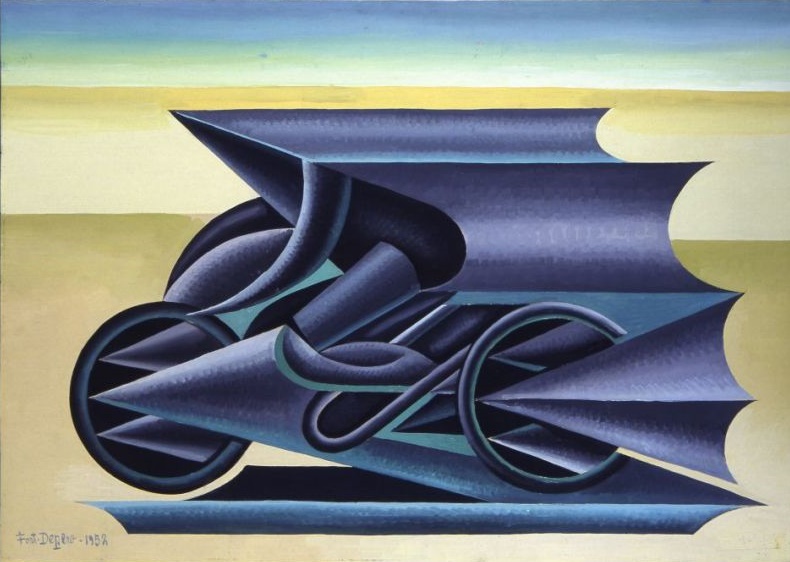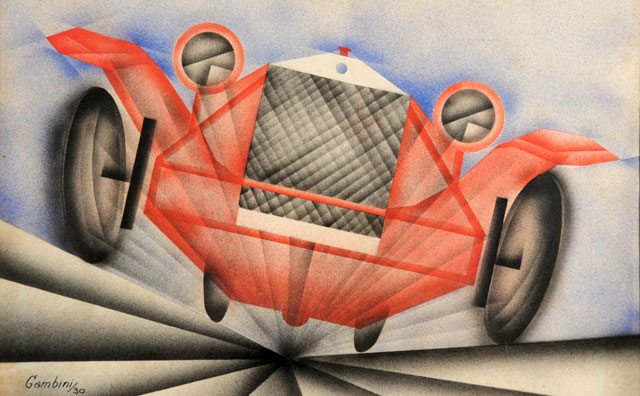La lentezza conquista la velocità: un video metafora del viaggio in tempo di pandemia
Un’idea semplice e geniale: la velocità esaltata dalla lentezza. Come gridare a bassa voce ma con tutto il fiato che si ha, così spostarsi restando fermi

Un’idea semplice e geniale: la velocità esaltata dalla lentezza. Come gridare a bassa voce ma con tutto il fiato che si ha, così spostarsi restando fermi

(English translation below)
Tempi duri per i futuristi. Dove è finita l’ebrezza della velocità, il viaggio frenetico in automobile e dell’aeropittura? Il rombo delle eliche? Dove può sfogarsi l’automobile da corsa col suo cofano adorno di grossi tubi simili a serpenti dall’alito esplosivo, per dove possiamo partire a bordo dell’automobile ruggente, che sembra correre sulla mitraglia, più bella della Vittoria di Samotracia?
Nel 1909 il Manifesto futurista proclamava “che la magnificenza del mondo si è arricchita di una bellezza nuova: la bellezza della velocità”, prodromo di un’idea dinamica dello spostamento, del viaggio esaltato per la sua rapidità; oggi invece siamo costretti ad azzerare i contatori e rifondare il concetto di viaggio. Se l’inizio di questo blog, se Rewriters, hanno coinciso con la pandemia, da parte mia mi sono sempre sforzato di indicare la strada di un felice cammino che continua anche fermo. Un viaggio, ormai, al rallentatore: viaggio fermo, viaggio tra i libri e i film, viaggio seduti sul tappeto, viaggio assaporando il tè, viaggio delle fotografie, e in mille altre declinazioni.
Una riscrittura che vale anche per il mito futurista delle corse in automobile. Qualcuno lo aveva anticipato: alla Biennale di Venezia del 2012 si era accolti, appena entrati nelle corderie dell’Arsenale, da un’installazione di Luca Bovoli che rovesciava le narrazioni: un video dai colori sfumati e le sagome umane indefinite, con la lettura del manifesto futurista di Marinetti da parte di alcune voci di persone afasiche.
Il parlare afasico è quanto di più lontano possibile da un ideale futurista: è lento e difficoltoso, incespica di continuo reinventando la punteggiatura, procede con sforzo, inframmezzato da pause e ripetizioni. Eppure, per contrasto, l’incedere da lumaca di questa lettura, esalta proprio il significato della velocità futurista, da una parte ridicolizzandola e rendendola obsoleta, dall’altra trasformandola in una velocità relativa e dissezionata.

Rileggiamo il Manifesto e immaginiamoci liberi di viaggiare al volante roboante: contempliamo lo spazio ristretto al quale siamo confinati; e ascoltiamo la lettura degli afasici della velocità futurista. Quest’ultima riconcilia gli estremi nei quali ci ritroviamo, il vorrei ma non posso, l’enunciato e il praticato. Bovoli e i suoi lettori temperano la nostra ansia. Perché se l’esito appare diverso, le parole sono le stesse, e così l’impegno nella lettura. Il massimo grado della velocità enunciata combinato al massimo grado di lentezza espressa: ci voleva un’opera d’arte per raccontare cosa sia diventato un aeroporto oggi, cosa siamo noi esploratori d’oggi. E come la velocità futurista, anche il nostro nomadismo diviene relativo, ma non per questo meno viaggio.
ENGLISH VERSION
A simple and brilliant idea, like shouting with a low voice but with all the breath you have, and moving around while standing still
Hard times for the futurists. Where did the thrill of speed, the frantic journey by car and of aeropainting go? The rumble of the propellers? Where can the “racing car with its bonnet adorned with large pipes similar to snakes with explosive breath” let off steam, where we can start aboard the “roaring car, which seems to run on the machine gun, more beautiful than the Victory of Samothrace”?
In 1909 the Futurist Manifesto proclaimed “that the magnificence of the world has been enriched with a new beauty: the beauty of speed”, a harbinger of a dynamic idea of displacement, of travel enhanced by its speed; today, however, we are forced to reset the counters and re-establish the concept of travel.
If the beginning of this blog, if Rewriters, coincided with the pandemic, for my part I have always tried to point the way to a happy path that continues even at a standstill. A journey, now, in slow motion: a stationary journey, a journey through books and films, a journey sitting on the carpet, a journey enjoying tea, a journey of photographs, and in a thousand other forms.
Such rewriting effort also applies to the futurist myth of car racing. Someone had anticipated it: at the 2012 Venice Biennale, as soon as one entered the Arsenale corderie, was welcomed by an installation by Luca Bovoli that overturned the narratives: a video with shaded colors and indefinite human silhouettes, with the reading of Marinetti’s futurist manifesto by some voices of aphasic people.
Aphasic speech is as far as possible from a futurist ideal: it is slow and difficult, it constantly stumbles reinventing punctuation, it proceeds with effort, interspersed with pauses and repetitions. Yet, by contrast, the snail-like engraving of this reading enhances the very meaning of futurist speed, on the one hand ridiculing it and making it obsolete, on the other transforming it into a relative and dissected speed.
Let’s reread the Manifesto and imagine ourselves free to travel behind the roaring wheel: let’s contemplate the corrent restricted space to which we are confined, and listen to the reading of the aphasics of futurist speed. The latter reconciles the extremes in which we find ourselves, the “I would like” versus the “I can’t”, the utterance and the practised. Bovoli and his readers temper our anxiety. Because if the outcome appears different, the words are the same, and so is the commitment into reading.
The maximum degree of speed enunciated combined with the maximum degree of slowness expressed: it took a work of art to describe what an airport has become today, what we, contemporary explorers, are. And like futurist speed, our nomadism also becomes relative, but with no less travelling.
